-
If you are citizen of an European Union member nation, you may not use this service unless you are at least 16 years old.
-
You already know Dokkio is an AI-powered assistant to organize & manage your digital files & messages. Very soon, Dokkio will support Outlook as well as One Drive. Check it out today!
| |
Ecology
Page history
last edited
by Darrell Sharp 11 years, 11 months ago
|
"Everything affecting everything else..."
The Botany of Desire
Michael Pollan

Levels of organization of Ecology, highlighting ecosystems. (Credit: Erle Ellis)
|
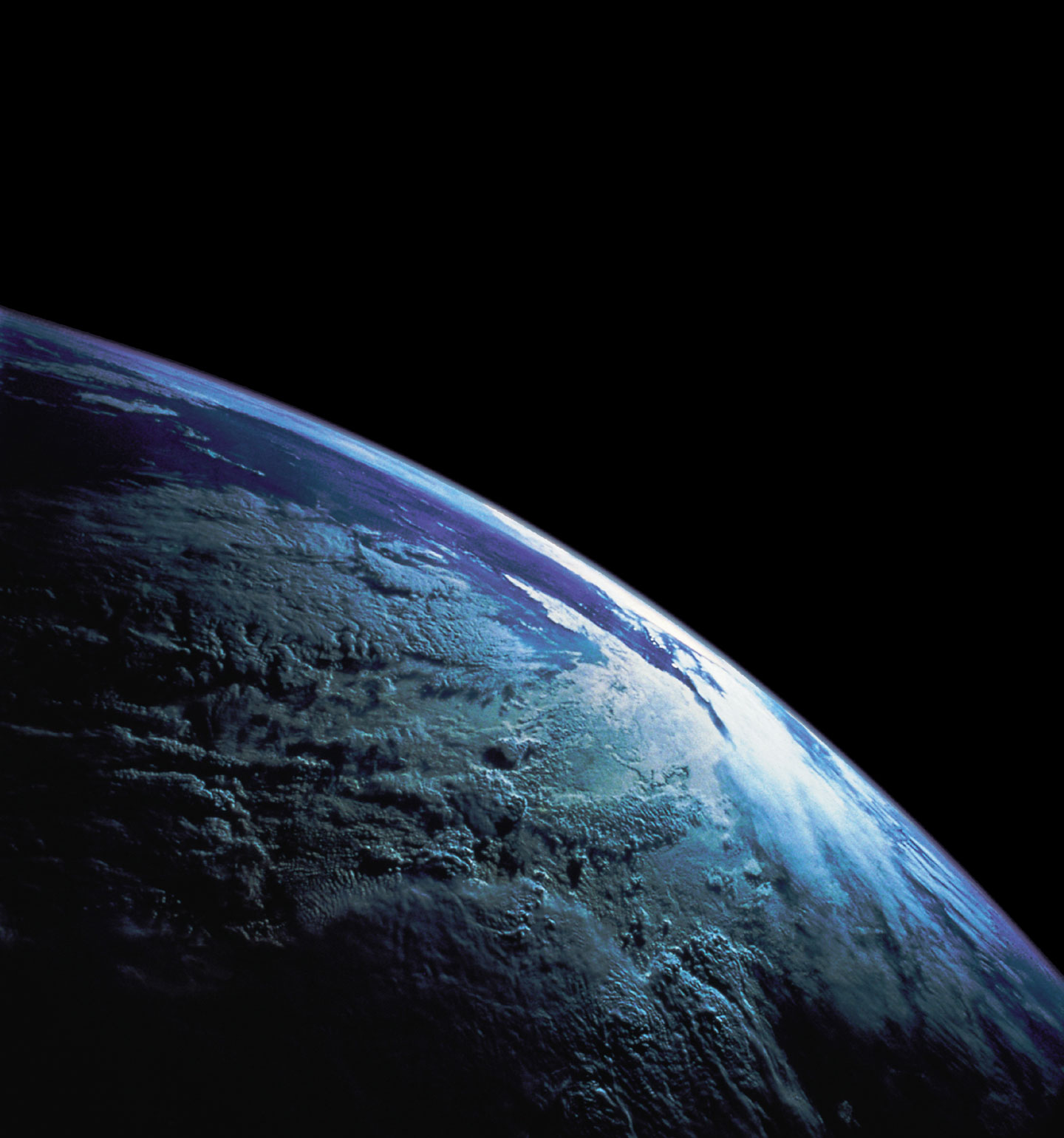
Planet Earth, BBC
|
5.1 Communities and ecosystems
|
Biochemical Oxygen Demand (BOD) Lab
Review Questions
|
|
5.1.1 Define species, habitat, population, community, ecosystem and ecology.
Species: a group of organisms that can interbreed and produce fertile offspring.
Habitat: the environment in which a species normally lives or the location of a living organism.
Population: a group of organisms of the same species who live in the same area at the same time.
Community: a group of populations living and interacting with each other in an area.
Ecosystem: a community and its abiotic environment.
Ecology: the study of relationships between living organisms and between organisms and their environment.
|
![[NotesLevelsOfOrganization2.jpg]](http://4.bp.blogspot.com/_sob8E7nEtu0/SkmqYE50g6I/AAAAAAAAAfI/MPALVUjU0eg/s1600/NotesLevelsOfOrganization2.jpg)
http://bio427.blogspot.com/2009_06_01_archive.html
|
|
5.1.2 Distinguish between autotroph and heterotroph.
Autotroph: an organism that synthesizes its organic molecules from simple inorganic substances.
Heterotroph: an organism that obtains organic molecules from other organisms.
|
Autotrophs make their own food by photosynthesis or chemosynthesis.

Heterotrophs get their food from other organisms.
|
|
5.1.3 Distinguish between consumers, detritivores and saprotrophs.
Consumer: an organism that ingests other organic matter that is living or recently killed.
Detritivore: an organism that ingests non-living organic matter.
Saprotroph: an organism that lives on or in non-living organic matter, secreting digestive enzymes into it and absorbing the products of digestion.
|

Illustration of the flow of matter and energy in ecosystems. (Credit: Erle Ellis)
|
|
5.1.4 Describe what is meant by a food chain, giving three examples, each with at least three linkages (four organisms).
Only real examples should be used from natural ecosystems.  indicates that A is being “eaten” by B (that is, the arrow indicates the direction of energy flow). Each food chain should include a producer and consumers, but not decomposers. Named organisms at either species or genus level should be used. Common species names can be used instead of binomial names. General names such as “tree” or “fish” should not be used. indicates that A is being “eaten” by B (that is, the arrow indicates the direction of energy flow). Each food chain should include a producer and consumers, but not decomposers. Named organisms at either species or genus level should be used. Common species names can be used instead of binomial names. General names such as “tree” or “fish” should not be used.
|
Grama grass --> Desert Cottontail --> Harris' Hawk
Phytoplankton --> Zooplankton --> Sand Lance (fish) --> Puffin (bird)
|
|
5.1.5 Describe what is meant by a food web.
|


http://w3.shorecrest.org/~Lisa_Peck/MarineBio/syllabus/ch11_ecosystems/ecosystem_wp/2008/vince/prod.html

http://oceanworld.tamu.edu/students/forams/forams_marine_food_web.htm
|
|
5.1.6 Define trophic level.
|
Trophic level: a group of organsims that have the same position relative to the producers in a food web.

|
|
5.1.7 Deduce the trophic level of organisms in a food chain and a food web.
Students should be able to place an organism at the level of producer, primary consumer, secondary consumer, and so on, as the terms herbivore and carnivore are not always applicable.
|

|
|
5.1.8 Construct a food web containing up to 10 organisms, using appropriate information.
|
Read the description of the anhinga below and draw a partial food web of a freshwater marsh ecosystem.
Include producers and consumers.
 
|
|
5.1.9 State that light is the initial energy source for almost all communities.
No reference to communities where food chains start with chemical energy is required.
|
Photosynthesis is the source of energy for most ecosystems.
(Chemosynthesis produces energy from molecules in the environment. Chemosynthetic bacteria are producers in some ecosystems)

|
|
5.1.10 Explain the energy flow in a food chain.
Energy losses between trophic levels include material not consumed or material not assimilated, and heat loss through cell respiration.
5.1.11 State that energy transformations are never 100% efficient.
Reference to the second law of thermodynamics is not expected.
5.1.12 Explain reasons for the shape of pyramids of energy.
A pyramid of energy shows the flow of energy from one trophic level to the next in a community. The units of pyramids of energy are, therefore, energy per unit area per unit time, for example, kJ m–2 yr–1.
|

|
|
5.1.13 Explain that energy enters and leaves ecosystems, but nutrients must be recycled.
|
Carbon, oxygen, nitrogen, and phosphorus move in biogeochemical cycles through ecosystems.
Carbon Cycle

Nitrogen Cycle

|
|
5.1.14 State that saprotrophic bacteria and fungi (decomposers) recycle nutrients.
|
Decomposers are essential for ecosystems because they recycle nutrients.
|
5.2 The greenhouse effect
|

|
|
5.2.1 Draw and label a diagram of the carbon cycle to show the processes involved.
The details of the carbon cycle should include the interaction of living organisms and the biosphere through the processes of photosynthesis, cell respiration, fossilization and combustion. Recall of specific quantitative data is not required.
TOK: What difference might it make to scientific work if nature were to be regarded as a machine, for example, as a clockwork mechanism, or as an organism, that is, the Gaia hypothesis? How useful are these metaphors?
|
See the diagram above for the carbon cycle.
|
|
5.2.2 Analyse the changes in concentration of atmospheric carbon dioxide using historical records.
Data from the Mauna Loa, Hawaii, or Cape Grim, Tasmania, monitoring stations may be used.
|

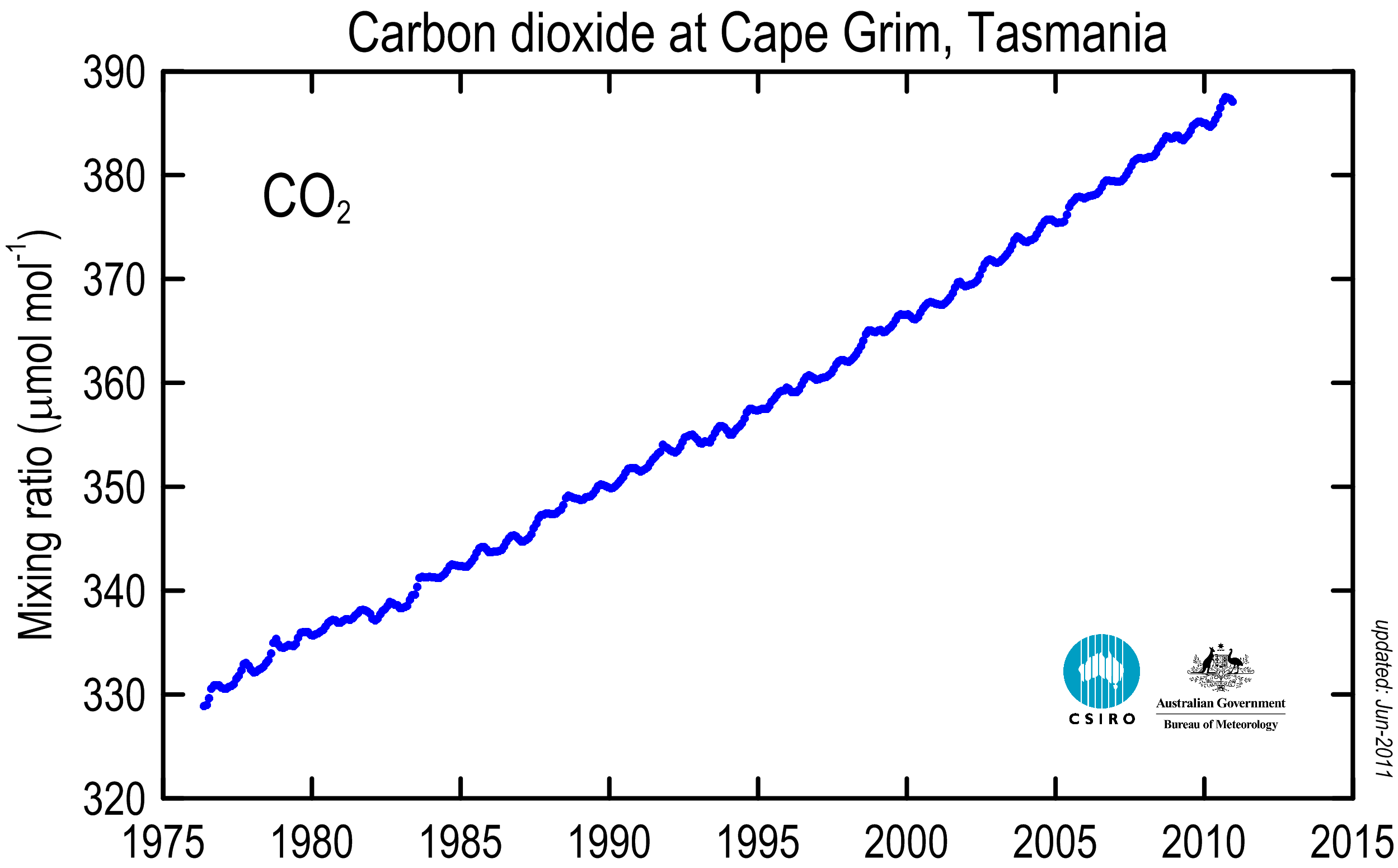
|
|
5.2.3 Explain the relationship between rises in concentrations of atmospheric carbon dioxide, methane and oxides of nitrogen and the enhanced greenhouse effect.
Students should be aware that the greenhouse effect is a natural phenomenon. Reference should be made to transmission of incoming shorter-wave radiation and re-radiated longer-wave radiation. Knowledge that other gases, including methane and oxides of nitrogen, are greenhouse gases is expected.
|
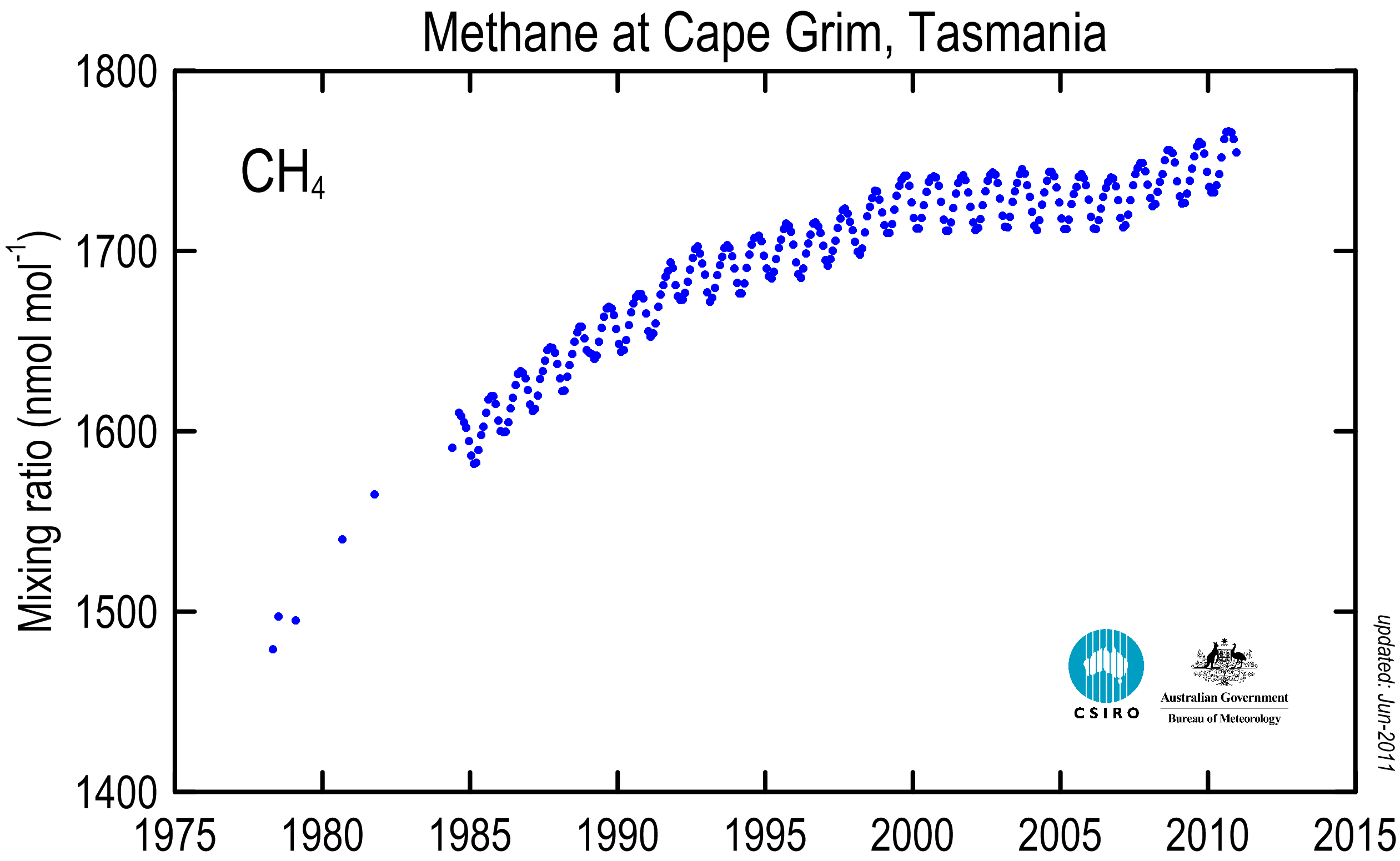
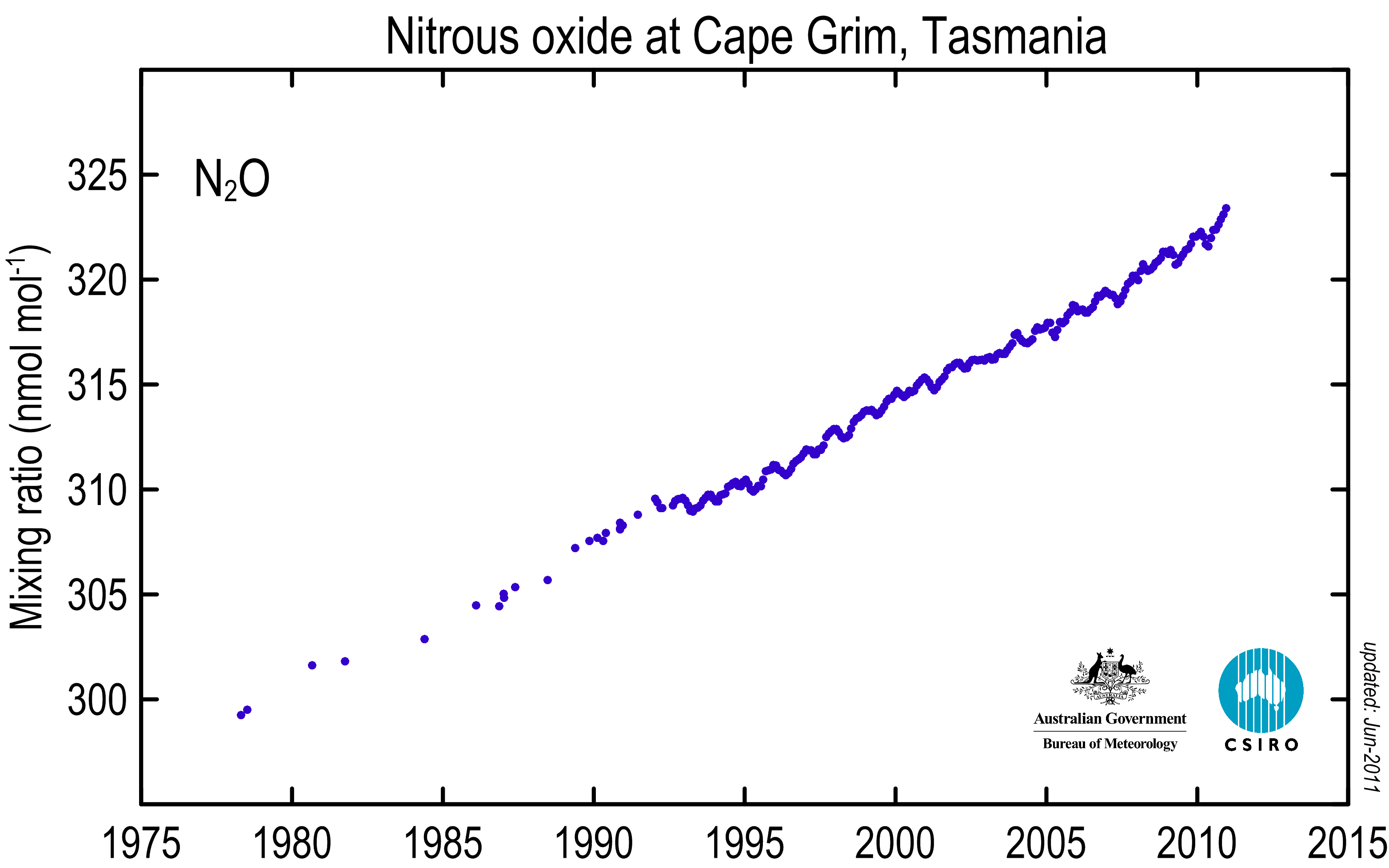
http://www.cmar.csiro.au/research/capegrim_graphs.html
What's happening with the greenhouse effect?
(Vocabulary: Sunlight = Solar Energy = Radiation)
Solar radiation changes wavelengths as it is reflected by the atmosphere and the earth's surface.
After the light reflects from the Earth's surface, it has a longer wavelength, also known as infrared light.
The greenhouse gases re-reflect the longer-wavelength radiation back to the earth's surface.
This makes it warmer.
The greenhouse effect is essential for life on Earth - it keeps us warm.
But....
Increasing greenhouse gases, increases the re-radiation of the longer wavelength energy, which increases the temperature even more.
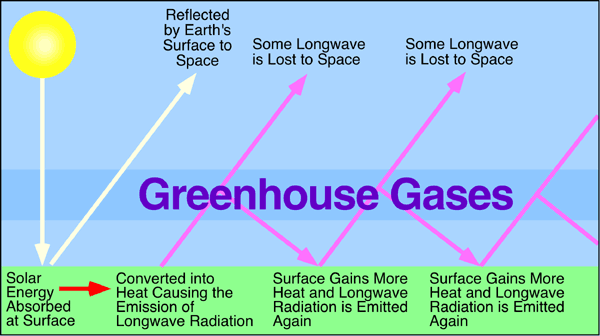
|
|
5.2.4 Outline the precautionary principle.
The precautionary principle holds that, if the effects of a human-induced change would be very large, perhaps catastrophic, those responsible for the change must prove that it will not do harm before proceeding. This is the reverse of the normal situation, where those who are concerned about the change would have to prove that it will do harm in order to prevent such changes going ahead.
TOK: Parallels could be drawn here between success in deterring crime by increasing the severity of the punishment or by increasing the chance of detection. If the possible consequences of rapid global warming are devastating enough, preventive measures are justified even if it is far from certain that rapid global warming will result from current human activities.
|
Question for business/industry/personal activity using the precautionary principle:
Can we prove that there will be no harmful effect because of our activity?
- If we can prove there will be no harmful effect, then we can proceed.
Common method:
Can others prove that our activity will do harm?
- We will proceed until someone can prove there is a harmful effect.
|
|
5.2.5 Evaluate the precautionary principle as a justification for strong action in response to the threats posed by the enhanced greenhouse effect.
Aim 8: Consider whether the economic harm of measures taken now to limit global warming could be balanced against the potentially much greater harm for future generations of taking no action now. There are also ethical questions about whether the health and wealth of future human generations should be jeopardized, and whether it is right to knowingly damage the habitat of, and possibly drive to extinction, species other than humans.
The environmental angle here is that the issue of global warming is, by definition, a genuinely global one in terms of causes, consequences and remedies. Only through international cooperation will a solution be found. There is an inequality between those in the world who are contributing most to the problem and those who will be most harmed.
|
IB Aim 8: The IB biology course aims to raise awareness of the moral, ethical, social, economic and environmental implications of using science and technology
Assess the implications and limitations.
What are the possible implications of global warming?
Is there evidence that greenhouse gases do not cause global warming?
Using the precautionary principle, what is the best course of action regarding greenhouse gas emissions?
|
|
5.2.6 Outline the consequences of a global temperature rise on arctic ecosystems.
Effects include increased rates of decomposition of detritus previously trapped in permafrost, expansion of the range of habitats available to temperate species, loss of ice habitat, changes in distribution of prey species affecting higher trophic levels, and increased success of pest species, including pathogens.
|

Possible effects:
more decomposition
more CO2
more temperate habitat
less CO2
less arctic habitat
changes in population sizes
changes in communities
|
|
5.3 Populations
|
|
|
5.3.1 Outline how population size is affected by natality, immigration, mortality and emigration.
Aim 7: Simulation exercises can be performed.
|
Population Simulation
Click the Population tab on the simulator
Click Start and watch how the population changes.
Describe the curve. What is the total population after 600 years?
Click Reset and change the Fertility to 2.
Click Start and watch.
Describe the curve. What is the total population after 600 years?
Click the Fertility tab on the simulator.
Change the Fertility and Mother's Age at First Birth to see how it affects the graph.
Click the Mortality tab on the simulator.
Change the three Mortality parameters to see how they affect the graph.
Use the Fertility Rate and Infant Mortality data to compare two countries with the simulator.
|
|
5.3.2 Draw and label a graph showing a sigmoid (S-shaped) population growth curve.
5.3.3 Explain the reasons for the exponential growth phase, the plateau phase and the transitional phase between these two phases.
|

Exponential Growth Phase
- natality and/or immigration are higher than mortality and/or emigration
- very few limiting factors allow exponential growth
Transition Phase
- charactreized by a lower rate of population growth than the exponential phase
- population is still growing: natality + immigration > mortality + emigration
- some resources are becoming limiting factors
- competition leads to natural selection
- ecology and evolution are connected
Plateau Phase
- the population has stopped growing and remains constant
- natality + immigration = mortality + emigration
- the population has reached carrying capacity due to limiting factors of the habitat at that time
|
|
5.3.4 List three factors that set limits to population increase.
|
Limiting Factors
- food
- predation
- parasitism
- disease
- space
- abiotic factors: water, heat, light, etc.
|
Ecology
|
|
Tip: To turn text into a link, highlight the text, then click on a page or file from the list above.
|
|
|
|
|
Comments (0)
You don't have permission to comment on this page.